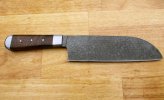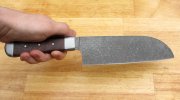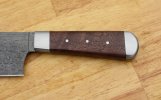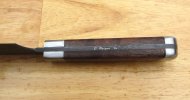Stacy's warning should be considered in full effect, even concrete cleaning and pool grade Muriatic--he's not too far off from saying it's similar to WWII German Mustard Gas, it's actually the precursor to Mustard gas and its WWII offshoot, the chlorine gas poison zyklon B: Phosgene, first used in WWI.
Phosgene is a cobalt chloride, one of the reasons newbies to welding are told to never clean surfaces to be arc welded with stuff like brake cleaner us the arc's UV light will convert the vapors to phosgene.
I was exposed to it in my teens when a jug of muriatic in our garage began leaking and dripped onto some crates we used for when we'd release farm raised quail into reestablishment preserves. Combined with the concentrated urea/ammonia from the bird poo left in the crates, a chlorine gas was formed, and quickly filled the small closed shop.
I'd been working at a bench grinder sharpening a mower blade, between the ozone smell and focusing on what I was doing, nothing seemed off...next thing I knew I was laying outside on the ground as my brother hosed me down. I got real lucky, I'd blacked out and, had my brother not come out to tell me I had a phone call, would have likely died. Within as probably as little as 5 minutes, the shop had filled with fumes, and I'd been out for probably less than two, but it was enough to cause severe chemical burns throughout my sinuses and throat.
My airways were literally raw, for six weeks nothing but light fluid diet and breathing through a respirator to avoid infection. Growing up in Doc Holiday's home town, the man's life is heavily glorified, however, I do not envy how the man passed if it was even remotely like those six weeks I spent hacking up chunks of scabbed nasty.
My sense of smell and taste have never been the same--like a schmuck, I'm still a pack to a pack'n'ahalf a day smoker, but had to swap brands several times as some take on a phantom flavor of that horrible gas.
Call your local university and see who supplies their chemicals and safety gear--they maybe able to recommend an affordable local source for acid rated masks. If you ask really nicely, you may find someone in the biochem department interested in what you're doing and they'll let you use a ventshield, if not outright do it with you.
Typical Nitrile, poly, or latex gloves won't provide amble protection--get the rubberized heavy chem gloves, but use medical cloth tape to add a gripping surface so a container of acid doesn't fly.
To store, like FC, Use a length of capped PVC, but I would suggest sealing with Rain or Shine glue (the blue stuff) it has a PTFE sealant that should protect against chlorides.
I would strongly suggest two fans and outdoors--one large fan aimed at you and a smaller desktop sized fan on the bench pointing away to pull fumes away from you.




